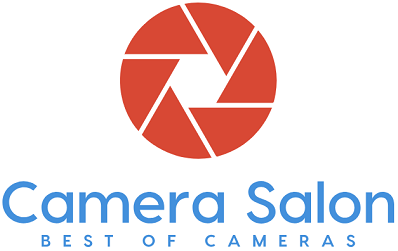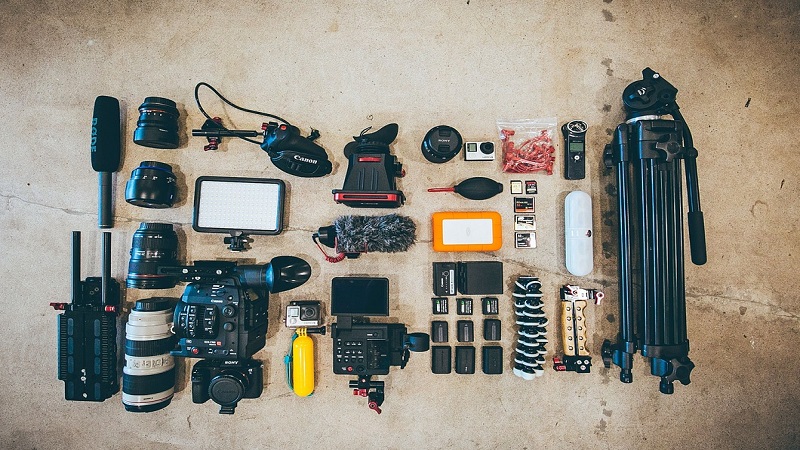Our article highlights the photography equipment list for beginners to get going in this profession.
Although the camera is the most important part of your kit yet you also need additional accessories to further enhance the quality of your images. Keep in mind that photography is an expensive profession. Even a beginner DSLR camera would cost you around $500. Supporting photography equipment can cost you anything from $10 to thousands of dollars. However, these accessories will not only help you take stunning photos effortlessly but also become a better photographer over time.
Necessary Camera Accessories
The following is the professional photography equipment list for every photographer, novice or experienced.
1. Lenses
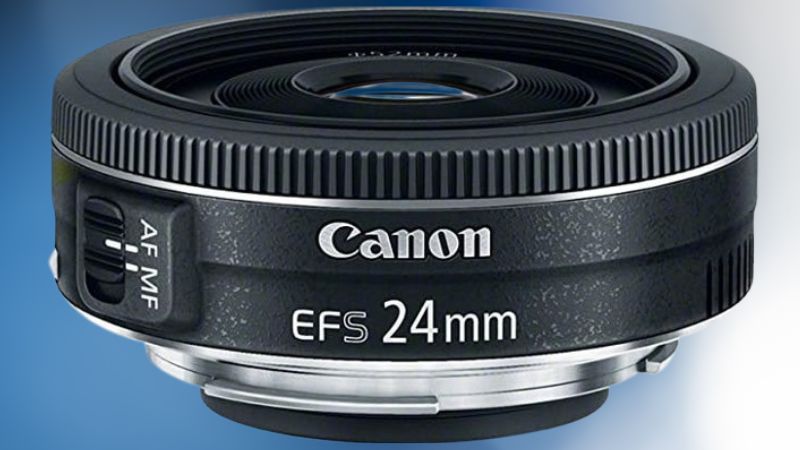
The lens is the first thing you should purchase after the camera. Most cameras do come with a standard kit lens but it cannot offer the quality you are looking for. You can also choose from a prime or zoom lens. However, you should go for the prime lens as a beginner. It does not have a variable focal length but the fixed focal length is hard to beat.
On the other hand, zoom or walk-around lenses can help you overcome different situations with only one lens thanks to their long zoom ranges. You can use the same length for portraits, landscapes, architecture, and other kinds of photography. It enables you to tackle anything and start your photography journey on the right note.
Using a walk-around lens would also help you determine the field of photography you are most interested in. You would know your direction after taking different types of snapshots. Subsequently, you can purchase a specialty lens to further your career in that particular field. For instance, the Canon EF-S 24mm f/2.8 STM or any other wide-angle lens is a good option for landscape photographers. Similarly, travel photographers would love the extremely lightweight and compact Canon 18-200mm f/3.5-5.6 IS.
2. Lens Filters

Lens filters can make your life as a photographer much easier. You can survive without them in our opinion but they should be an integral part of your photography kit. They not only protect your lens from all kinds of damage but also enhance the image quality. The most important types of lens filters are as below.
Polarizing Filters
If you want to increase the contrast between skies and clouds, you must use a polarizing filter. You can change the effect by manually using the secondary rotating mount the polarizers come with. They increase the color saturation by darkening very light skies. They would also eliminate reflections and glare when used on water.
Polarizing filters are extremely popular among landscape photographers. However, you should think long and hard before using them on a wide-angle lens. You should especially be careful while shooting blue skies because they can haphazardly darken some parts.
Some of the best polarizers you can buy today are Amazon Basics 58mm Circular Polarizer Camera Lens Filter and 52mm X2 CPL Circular Polarizing Filter for Camera Lenses.
Ultraviolet Filters
The ultraviolet filters are the cheapest and most basic types of filters. Also known as Haze filters, they reduce haziness by blocking the ultraviolet light waves using a coating on the glass. However, their primary purpose is to protect your lens from dust, dirt, splashes of water, and other kinds of damage.
Some UV filters have a special multi-resistant coating. You should always get these filters if you can afford them. Keep in mind that it is easier and cheaper to change a damaged filter than a damaged lens.
The best ultraviolet filters to choose from are the 58mm Amazon Basics UV Protection Camera Lens Filter and the Waka 58mm MC UV Filter.
ND Filters
The main job of ND filters is to decrease the amount of light entering the lens. They are gray-toned filters that decrease the shutter speed and increase the exposure while doing so. As a result, they are perfect filters to be used in low light conditions.
You can also use ND filters to capture movements on busy roads or make waterfalls smooth and silky in your photos. Similarly, you should use ND filters only when necessary.
When it comes to the best ND filters, there are a lot of options. However, Tiffen 77VND 77mm Variable Neutral Destiny Filter and Breakthrough Photography 77mm X2 6-Stop Fixed ND filter are our top two choices.
3. Lens Cleaning Kit
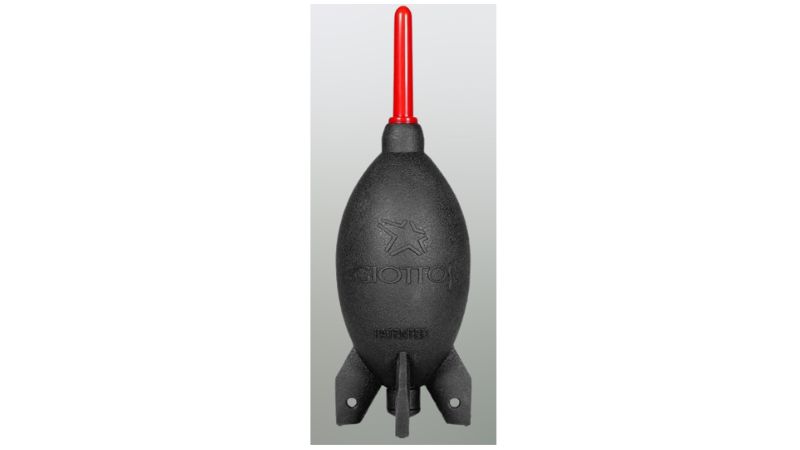
The lens cleaning kit is one of the top photography equipment to have. Your camera and lens are always exposed to dust, dirt, debris, and elements. Similarly, you can easily leave your fingerprint on the lens as well. They are also prone to scratches and other damage. Do we have to mention even a small spot of dust can ruin your images? A good cleaning kit can keep your equipment clean and brand new for a long time.
You should also clean your camera and lens with utmost care. Haphazard cleaning can cause more damage to your camera than dirt or debris. As a result, we only recommend the best and most professional cleaning kits such as Giottos Rocket Air Blaster and Altura Photo Professional Cleaning Kit. In general, a good cleaning kit should consist of the following items.
- Dry sensor cleaning swabs
- Sheets of lens tissue paper
- Microfiber cloths
- Natural cleaning spray
- A lens brush
- An air blower
4. Sensor Cleaner
You better leave sensor cleaning to a professional if the problem is not related to dust only. You can easily remove dust from the sensor using an air blaster such as the Rocket Air Blaster. It is not only cheap but a very effective sensor cleaner as well. You can even create a very good lens cleaning kit just by combining a lens cloth and the Rocket Air Blaster.
5. External Flash

Lighting plays a pivotal role when it comes to taking beautiful snapshots. You can open doors to countless opportunities and explore unbeaten paths by making your own ambient light. The right lighting is especially important for studio photography but you also need perfect light for all kinds of photography.
The best and easiest way to illuminate the shoot location efficiently is using a speedlight. You can sync it directly to the camera shutter. As a result, it offers an incredibly powerful burst of light within the blink of an eye. The best part; you can easily find an excellent speedlight quite easily because most camera brands and third-party manufacturers make them in huge numbers.
If you are looking for a speedlight that offers you everything you need, you must consider Canon Speed-lite 430EX II Flash. It has the following features.
- Full coverage
- Easy installation or mounting
- Automatic and manual control settings
- Can be used as an independent wireless “slave” unit
Besides, beginner photography can easily carry it because of its small size. It also fits in every camera bag you can imagine.
6. Reflectors
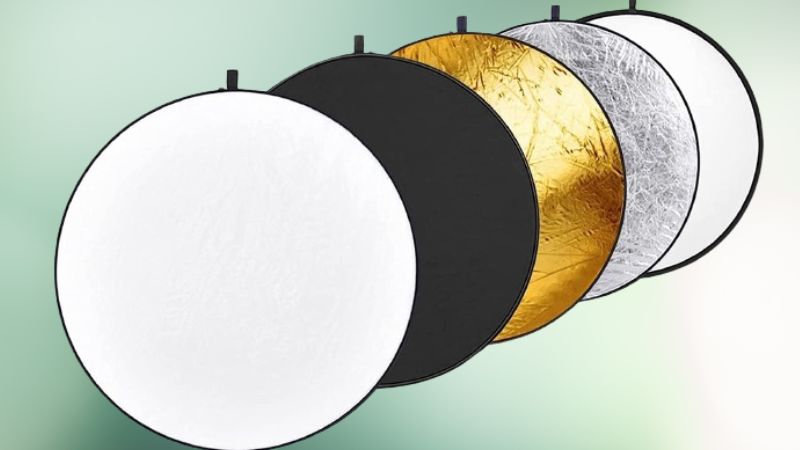
You can always use a speedlight to improve the light quality of the scene. However, the light is not always natural. For a more natural, you can use another very nice photography tool known as a reflector. As the name suggests, the main role of the reflector is to reflect the light to darker places. All you need to do is to reflect the light to the shadow place by changing the angle of the reflector. It will help take some terrific images.
The best thing about reflectors is that they are cheaper and easier to use compared to speedlights. Similarly, the images look more natural because you are practically using natural light.
Neewer 43 inch/1110 Centimeter Light Reflector is the best reflector on the market if you are interested in buying one.
7. Tripod

Another basic tool on our photography equipment list is the tripod. As you already, its sole purpose is to stabilize the camera to eliminate image blurs. Tripod is an indispensable part of portrait, landscape, macro, architecture, and long-exposure photography in particular. Some photographers argue that you don’t need a tripod. However, a time will come when you will use literally anything within your reach as a tripod.
Therefore, you must buy a quality tripod according to your requirements and budget. Tripods come in many shapes, sizes, heights, weights, and load capacity. The following are our top choices.
- Joby GorillaPod Focus with Ballhead
- Manfrotto 055 Aluminum 3-Section Tripod
- Pedco UltraPod Lightweight Camera Tripod
8. External Hard Drive

Modern DSLRs and mirrorless cameras have substantial built-in storage space. But – it is bound to run out at some point of your photography tour. To avoid such problems, you can always use an external hard drive. Similarly, you can save your precious images and videos for later use in case your camera or computer suddenly fails. All the good photographers always have a couple of backup storage options all the time.
Remember that image files are getting bigger and taking up more space because of the ever improving quality of the cameras. Therefore, it is quite useful to have an external hard drive. A hard drive with terabytes of storage space such as HGST Touro S Portable Drive can help you store thousands of images with the utmost ease.
9. Memory Cards
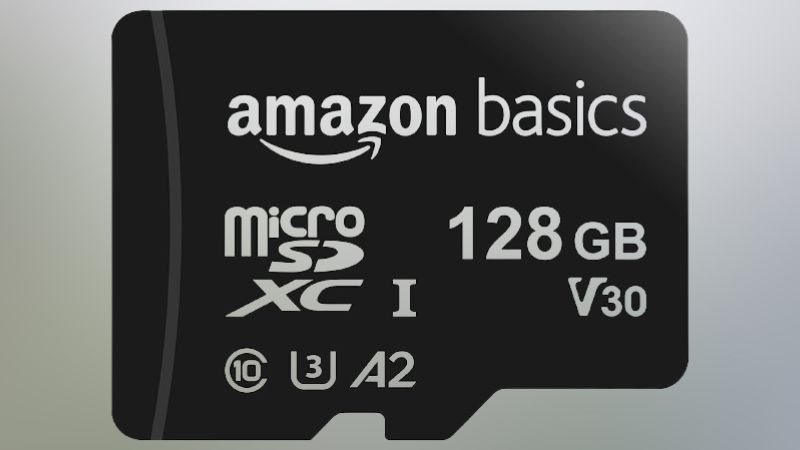
Apart from external hard drives, memory cards are also one of the most basic yet important photography equipment for beginners. You cannot store an image if you don’t have a memory card in your camera. Therefore, you need to have a decent collection of memory cards to survive as a photographer.
Almost all modern cameras have at least one slot for small SD cards. Similarly, SD cards tend to be very inexpensive, and therefore, you can find them anywhere you want. They are available at specialized photography shops as well as local convenience stores.
Some latest DLSR and mirrorless models also have ports for Compact Flash (CF) cards. They are larger compared to SD cards and much more durable as well. They are also more expensive but offer similar capacity and speed as SD cards.
10. Memory Card Reader
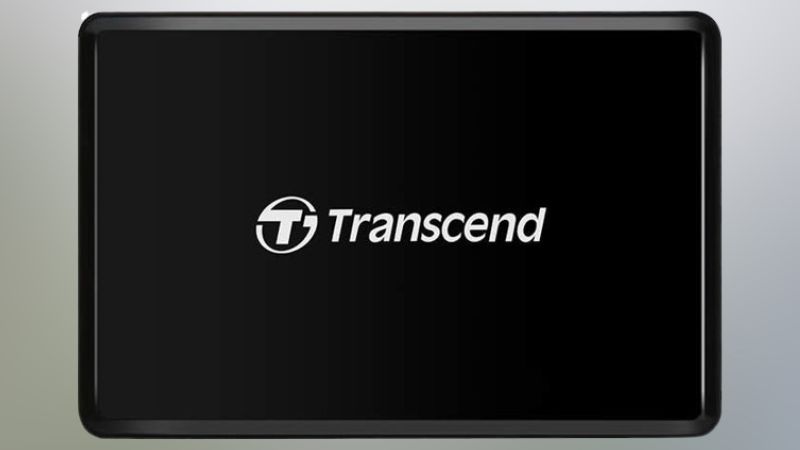
You not only need memory cards but a fast memory card reader as well. It ensures faster transfer of photos from camera to computer, saving you a lot of time. In general, the card reader is one of the best photography equipment.
There are thousands of memory card readers on the market but we really like Transcend Multi-Card Reader. It can read all types of cards including SD cards, Micro SD cards, and CF cards.
11. Photo Editing Software
Post-processing is the most important part of photography. For that, you also need good photo editing software and everybody knows that none is better than Lightroom or Adobe Photoshop.
These tools can help you completely change the image and make it look like you want. Photoshop and Lightroom are essential for every photographer who likes to take RAW images.
12. Rechargeable Batteries

Your camera and other equipment such as remotes, syncs, and speedlights can run low on power after prolonged use. Things can go bad if you have no power source to recharge them and this is where rechargeable batteries come to your rescue.
It is always handy to have standard AA batteries in photography. They can keep your photography equipment, especially remotes and speedlights working.
It can be devastating to know that your photography equipment requires recharging when you are in the shoot location. However, you can overcome the situation by having rechargeable batteries in your bag. They can help you continue shooting for as long as you want.
Apart from batteries, it is also advisable to have a good battery charger such as EBL 8 Bay Smart AA/AAA Battery Charger. They support both AA and AAA batteries and are a great option to keep your equipment in working order.
13. Studio Photography Equipment
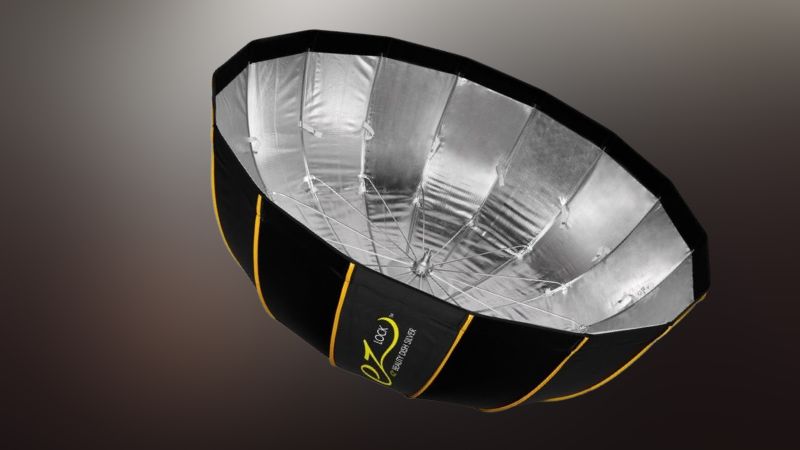
The studio photography equipment list contains many more items than general photography. These items include everything from backdrops, props, models, and lights. However, you just need some entry-level lights such as umbrella lights or softbox lights if you have just set up your studio. When it comes to backdrops, canvas, Muslin, cotton, and seamless paper will do the job just fine.
14. Cable Release
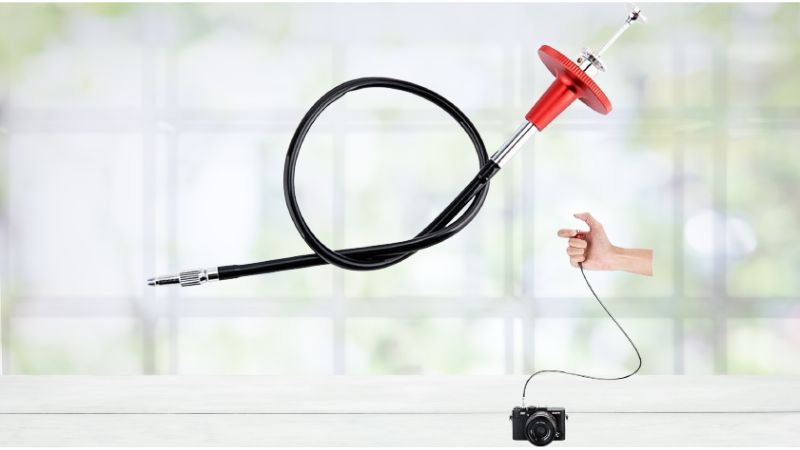
You should use a tripod for crisp, sharp, and detailed photos. However, you can also ruin an image just by pressing the camera shutter and this is where a cable release can come to your help. It will prevent all types of camera shakes and vibrations that may result in a blurred image. You can also use a Wi-Fi shutter release if your camera has Wi-Fi capability.
The best cable release in our opinion is JJC Mechanical Release Shutter Cable.
15. Remote

Another way to eliminate camera shakes is to use a remote. It can become your biggest friend if you want to take your images to the next level. Your images can lose sharpness due to the slightest movement, especially while taking long exposure shots at night. A remote can ensure your camera remains stationary while you press the shutter.
Keep in mind that not all remotes are compatible will all camera models. However, the best one is the Canon RC-6 Wireless Remote Controller.
16. Camera Straps
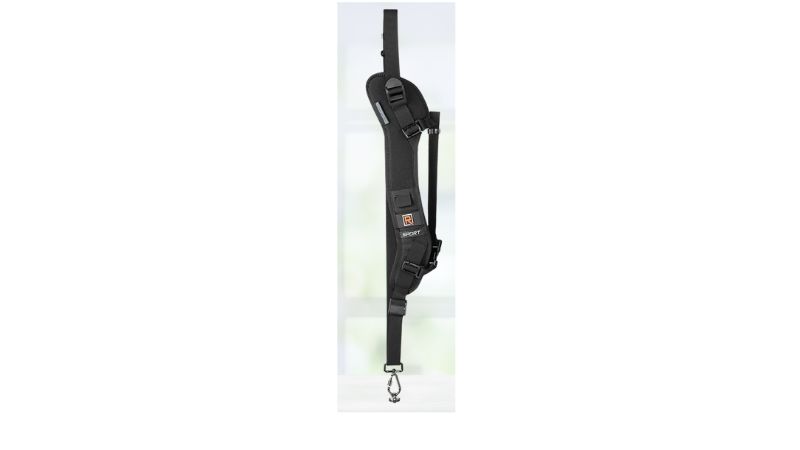
Although they don’t seem as important, the camera straps are among the best photography equipment to have. They not only enable you to travel extremely light but also keep your camera safe and secure. You don’t need to haul the bag along as well. On top of that, you can choose from numerous and very cheap camera straps. Therefore, it is better to buy several of them for a fashion statement.
However, professional photographers usually opt for more expensive straps because they prefer quality over quantity or aesthetics.
If you are looking for a functional camera strap, you should consider the Black Rapid Sport RRS-1BB Shoulder Sling Strap. The padded strap is very comfortable to wear.
17. Cable Organizer

Jumbled cables are annoying for everyone no matter you are a regular person or a professional photographer. You must learn cable management as a photographer. Experienced photographers such as Casey Neistat have mastered the art of managing cables. However, beginners like us are not as perfect as him. Therefore, we need a good cable organizer in the likes of Skooba Cable Stable DLX. It allows you to store batteries, cables, and small gear with the utmost ease.
18. Camera Rig Case
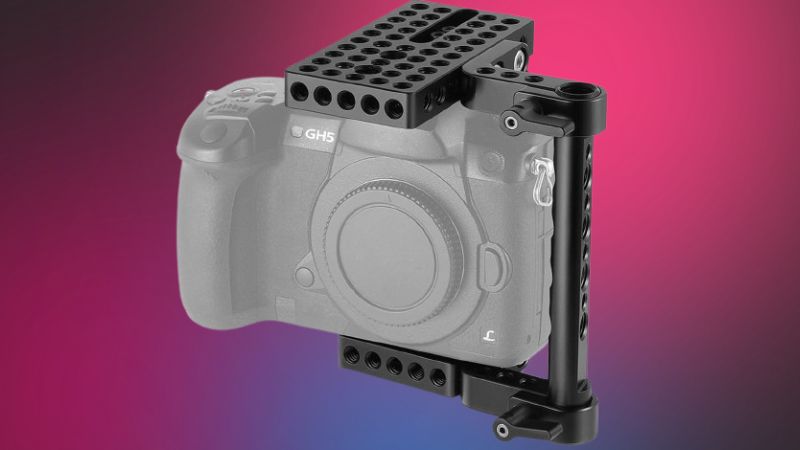
Everyone wants to protect his expensive camera. A camera rig case or cage can protect your camera from damage if it gets dropped or tussled. We also recommend using a camera case instead of a camera clip because the earlier offers better protection. Besides, it also improves the quality of your videos.
You must consider SMALLRIG Camera Cage if you are looking for an excellent camera case. It keeps scratches at bay thanks to the rubber cushion on top. Similarly, it can adjust to the size of different cameras.
19. Tethering Cable
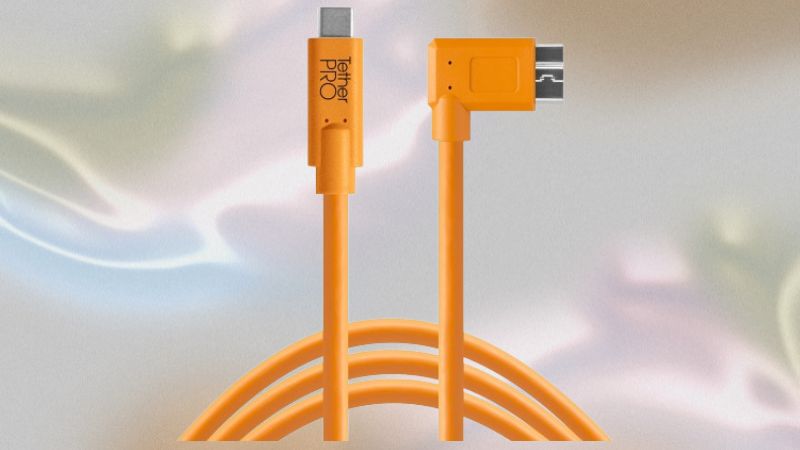
One of the best methods to take excellent images with fewer shots is tethering. You can transfer your photos straight to your computer by using a tethering cable. As a result, it helps you identify problems with focusing, composition, and lighting as you watch the images on a larger screen.
20. Bag or Carrying Gear

The last gear on our photography equipment list is the bag or a carrying case. You need something to store all of your equipment. A wide variety of bags are available, depending on your needs.
For instance, the Pelican 1510 Case is an excellent option if you have to travel by plane or long distances. It is extremely secure and sturdy and thus, keeps your fragile gear protected and strapped down. The bag also has a retractable handle and wheels for easy movement.
The Pelican 1510 is a huge case and is not practical for short distances or if you want to travel light. For light travel, you can go for the Gogroove Full-Size DSLR Photography Backpack Case. It is lightweight and compact but can pack all of your essential photography gear.
Also Read: 15 Best Wedding Photography Tips For Beginners
Final Thoughts
With this, we conclude our professional photography equipment list. All these tools will enable you to enhance your photography skills besides making photography much easier for you. However, you must try taking some photos with your camera and kit lens only before buying these accessories. It will help you find your strengths and weaknesses besides discovering your preferred niche.
